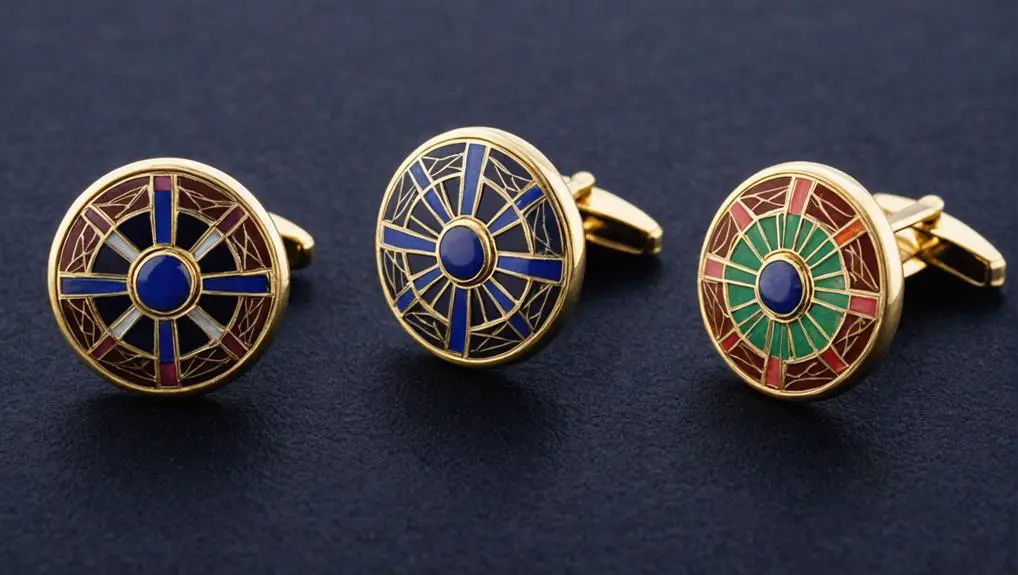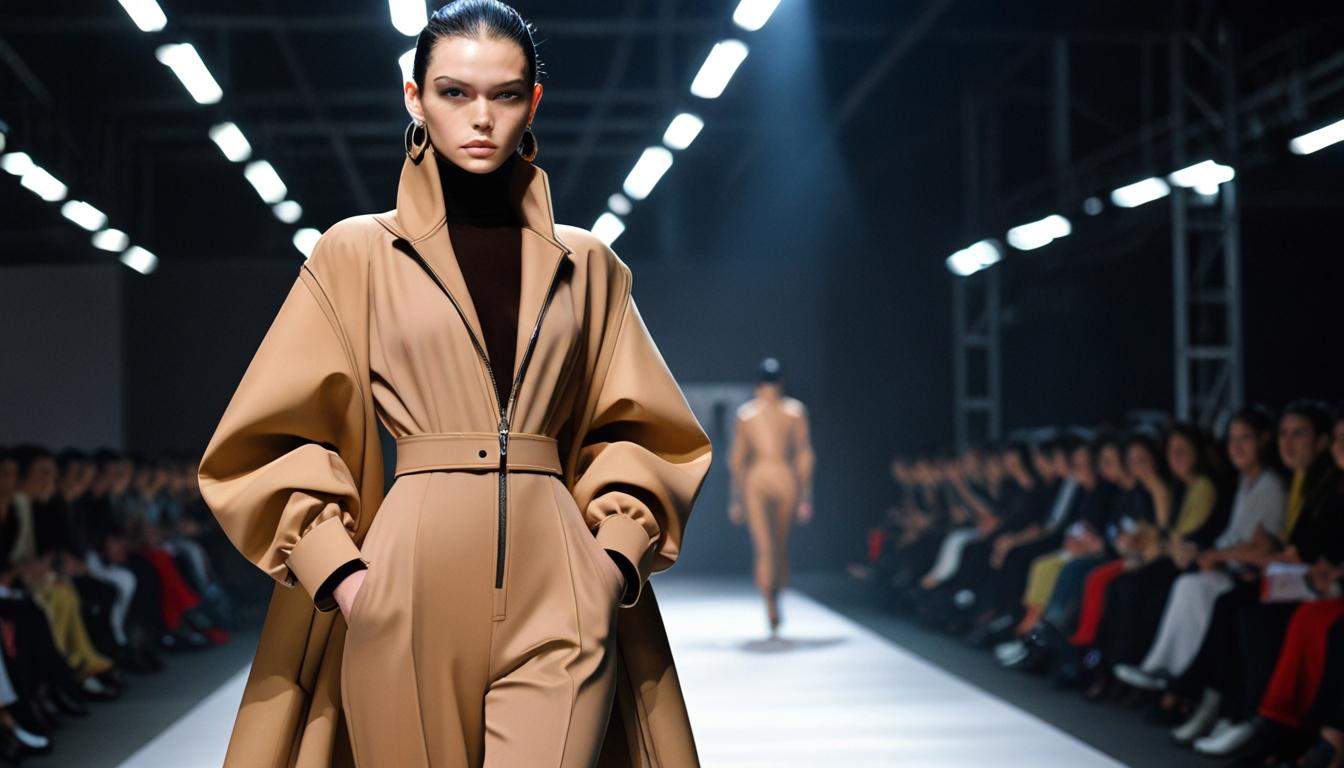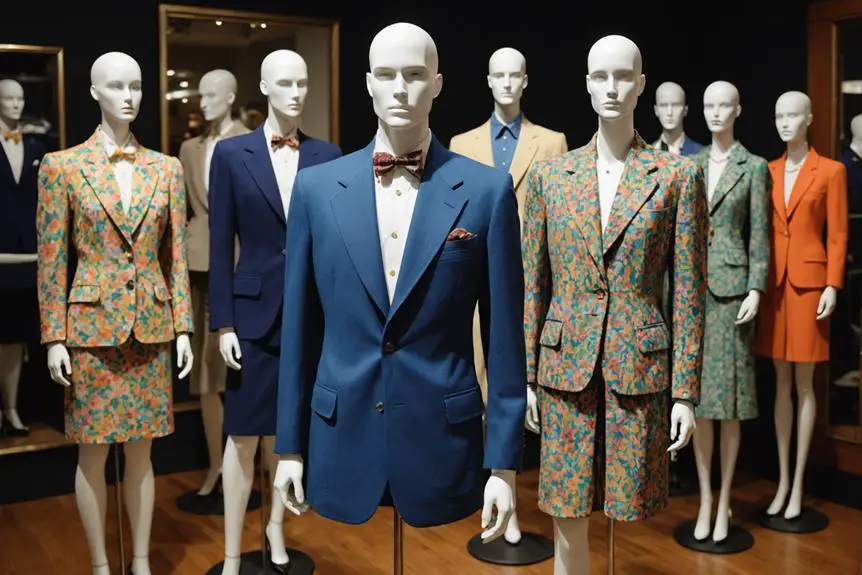In the 1930s, men's cufflinks became essential style statements, reflecting the opulence of the Art Deco movement. You'd find designs featuring intricate geometric patterns, bold colors, and luxurious materials like 18k gold and sparkling gemstones—diamonds, rubies, and sapphires. Cufflinks were often handcrafted, showcasing unique artistry from places like Britain, France, and America. Chain-linked articulations combined elegance with functionality, making them a favorite choice. Brands like Tiffany & Co. created iconic pieces that not only adorned shirts but also signified status. Discovering the rich history behind these vintage treasures reveals even more about their allure and significance.
Geographical Origins of Cufflinks
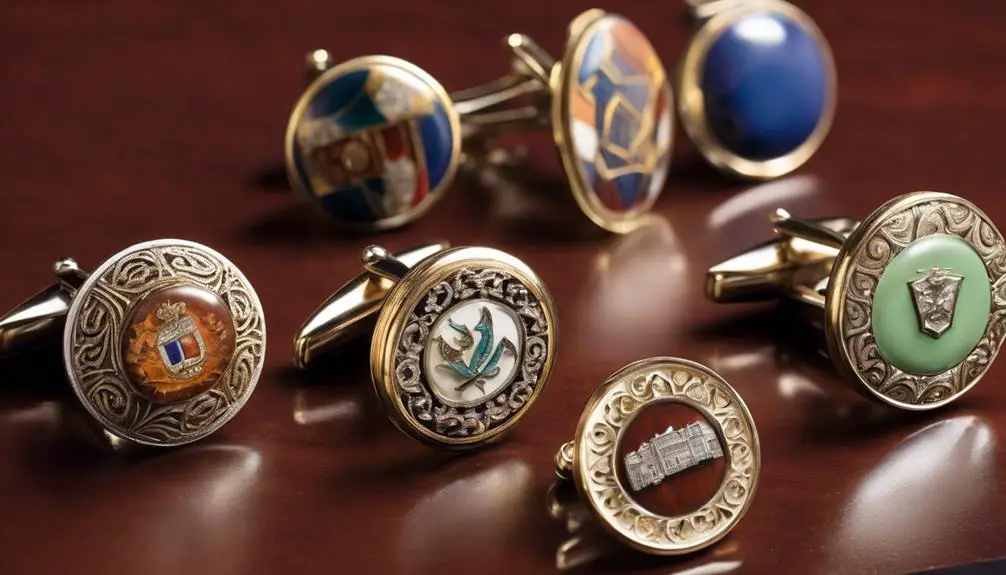
As you explore the world of men's cufflinks from the 1930s, you'll quickly notice how their geographical origins profoundly influenced their design and materials. British Art Deco cufflinks, often crafted in London, showcased luxurious elements such as diamonds, rubies, and gold, exemplified by intricate pieces like the Art Deco Diamond, Enamel, and Gold Cufflinks from circa 1935. Meanwhile, American designs, particularly from Mount Kisco, NY, prominently featured sapphires and 14k gold, with standout examples like the Vintage 14 Karat Yellow Gold Knot Sapphire Cuff Links.
French cufflinks, crafted in London yet reflecting exquisite French artistry, typically showcased onyx and platinum, as seen in the Art Deco Ruby and Onyx Platinum Cufflinks from circa 1930. Norwegian designs introduced a unique flair, utilizing silver and enamel, highlighted by the 1930 Nordic Cufflinks by J. Tostrup. Even Madrid contributed to the trend with rare combinations of diamond, sapphire, and 18k gold, illustrating the diverse influences that shaped cufflink design during this iconic decade. Each cufflink tells a story, connecting you to the rich tapestry of Art Deco craftsmanship and cultural heritage.
Materials and Craftsmanship
Cufflinks from the 1930s epitomize luxury, showcasing a stunning array of materials that reflect the opulence of the Art Deco era. You'll find gold cufflinks, often crafted from 18k gold, paired with exquisite gemstones like diamonds and sapphires, creating a lavish statement. Silver, particularly Art Deco sterling silver, also played a significant role, enhancing the elegance of these accessories.
Intricate designs featuring Enamel Cufflinks were particularly popular, showcasing the artistic flair that defined this period. The vibrant colors and meticulous detailing in these pieces not only highlighted skilled craftsmanship but also added a unique touch to each cufflink.
Artisans used handcrafted techniques, ensuring that every piece was distinctive, with unique patterns and finishes that set them apart. The combination of functionality and flair was achieved through chain-linked articulation, allowing for easy wear while maintaining a sophisticated look.
These cufflinks were more than just accessories; they were a celebration of Antique Art and craftsmanship, embodying the grandeur and attention to detail that characterized the 1930s. Each pair tells a story, inviting you to embrace the elegance of the era.
Styles and Design Trends
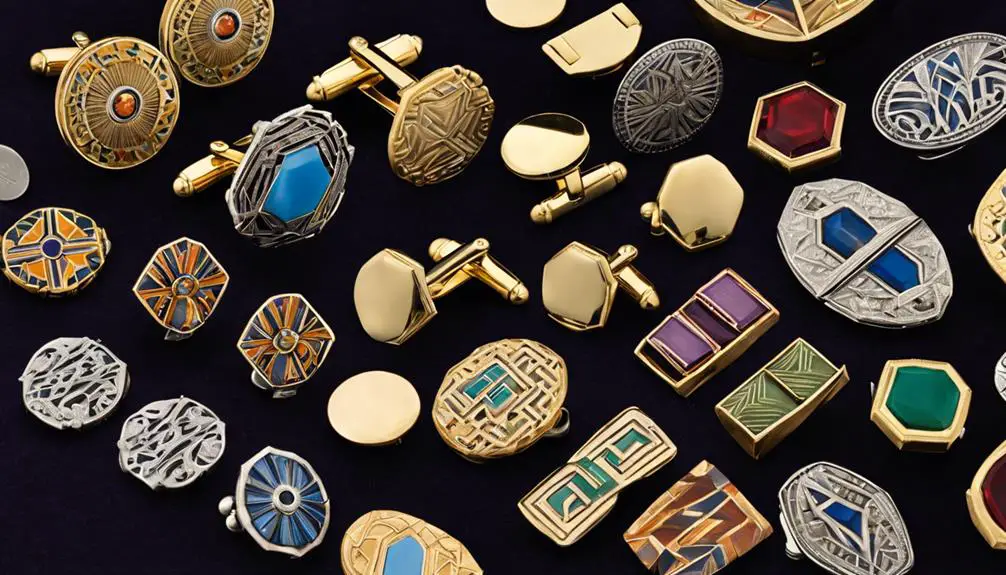
The 1930s were a vibrant time for men's fashion, and cufflinks became a key accessory that reflected the era's bold styles and design trends. The Cufflinks Art Deco movement defined this decade, showcasing geometric shapes and luxurious materials. You'd find gold-plated designs that gleamed under the light, often featuring intricate patterns that captured attention. Vintage cufflinks from this period frequently highlighted Art Deco enamel, with eye-catching colors like blue enamel adding flair to any formal outfit.
Chain cufflinks emerged as a stylish trend, blending elegance with functionality thanks to their connecting chain feature. These pieces not only served a purpose but also showcased the craftsmanship of renowned brands like Tiffany & Co. and Cartier. Each cufflink told a story, often adorned with gemstones like diamonds and sapphires, elevating them to true works of art.
Whether you opt for classic French cufflinks or a bolder statement piece, embracing these antique and vintage designs allows you to channel the sophistication of the 1930s. In this era, cufflinks weren't just accessories; they were a declaration of style and status.
Market Insights and Availability
Exploring the market for vintage cufflinks from the 1930s reveals a treasure trove of unique styles and craftsmanship that captivates collectors and fashion enthusiasts alike. With 89 listings currently available, you'll find a stunning array of options, particularly in the Art Deco style, which features striking geometric patterns and luxury materials. This era's designs stand out, making them highly sought after by those looking to elevate their accessory game.
As collector interest grows, the value of these vintage cufflinks increasingly hinges on provenance and condition. Authenticity and historical significance are essential elements that discerning buyers pay close attention to. Prices vary widely, with many cufflinks ranging from $10 to $800, illustrating the diversity within this collectible segment. This broad price range means there's something for everyone, whether you're just starting your collection or seeking a rare gem.
Online marketplaces like 1stDibs enhance visibility, connecting sellers with a wider audience and allowing you to discover unique pieces from various geographical origins. Immerse yourself in this vibrant market, and you're sure to find cufflinks that resonate with your style and story.
Notable Cufflink Features
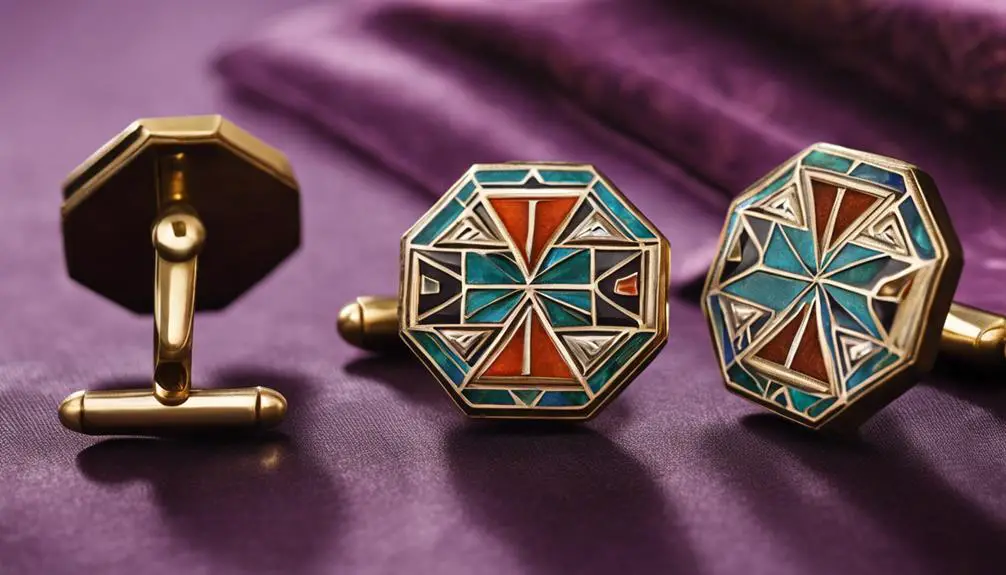
Amid the charm of the 1930s, cufflinks emerged as exquisite symbols of sophistication and style. You'd find Art Deco cufflinks at the forefront, showcasing intricate geometric patterns and bold colors that defined the era. Crafted from sterling silver and adorned with vibrant enamel, these cuff links weren't just accessories; they were statements of elegance.
The allure of rare gemstones, such as Deco Diamonds, rubies, and sapphires, elevated these pieces into the domain of luxury. Imagine slipping on a pair of Ruby Diamond cufflinks, their brilliance catching the light as you moved. Notable brands like Tiffany & Co. and Cartier produced iconic designs, ensuring that their craftsmanship remained unparalleled.
Unique features like hand-engraved patterns and engine-turned decorations added a personal touch, while innovative chain-linked articulation provided both style and functionality. Personalization became a trend, allowing you to monogram or engrave your cufflinks, making each pair uniquely yours. In the 1930s, cufflinks were more than just adornments; they were a reflection of your individuality and taste, setting you apart in any formal gathering.
Vintage and Antique Cufflinks
Vintage and antique cufflinks from the 1930s are treasures that capture the essence of an era defined by elegance and artistry. The Art Deco movement brought forth geometric shapes and bold colors, transforming cufflinks into statement pieces. When you explore this enchanting period, keep an eye out for:
- Intricate Craftsmanship: Many vintage cufflinks showcase unique artisan techniques, making them highly sought after by collectors. Understanding the historical context of vintage clothing labels can enhance your appreciation for these accessories.
- Luxurious Materials: You'll often find cufflinks made from 14k and 18k gold, sterling silver, and adorned with enamel and precious gemstones like diamonds or sapphires.
- Chain-Linked Articulation: This popular design feature not only enhances elegance but also provides functionality, making these cufflinks perfect for any occasion.
The collectibility of these antique cufflinks can greatly appreciate over time, influenced by factors like rarity, condition, and provenance. Whether you're a collector or someone looking to elevate your style, investing in vintage cufflinks from the 1930s is a fantastic way to embrace history while adding a luxe touch to your wardrobe. Their timeless appeal makes them a perfect accessory for modern men who appreciate the finer things in life.
Frequently Asked Questions
When Did Men Start Wearing Cufflinks?
Men started wearing cufflinks in the 16th century, evolving from simple silk ties to ornate accessories. Over time, they became essential for showcasing personal style and sophistication, especially during formal occasions. You'd definitely want to wear them!
Did Men Wear Cufflinks in the 1920s?
Yes, men wore cufflinks in the 1920s, embracing the Art Deco style. You'd find geometric patterns and luxurious materials like gold, silver, and gemstones, enhancing their tailored suits and making every outfit shine.
What Was the Purpose of Cufflinks?
Cufflinks aren't just functional; they're a statement. You use them to secure your cuffs, but they also express your style, wealth, and personality, transforming an ordinary outfit into something truly remarkable and sophisticated.
What Do Cufflinks Say About a Man?
Cufflinks reveal your personality and style, showcasing your attention to detail and sophistication. They signal confidence and formality, reflecting your taste and social status, while offering a chance to express your individuality through unique designs.
